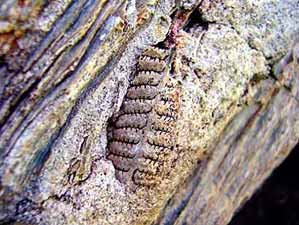
DIMAS DIAS-BRITOThe fossilization of ferns in the Tocantins Petrified Forest has preserved internal and external structures, as in this leafDIMAS DIAS-BRITO
Here and there imposing “chapadas” [a family of trees] rise into the air and break up the flat green landscape in the municipality of Filadélfia, in the north of the state of Tocantins. There, where the dark waters of the River Tocantins begin to bathe Maranhão State, creating the beaches that are so much sought after by tourists, the twisted trees of the Cerrado sometimes give way to the stunted, dry bushes of the Caatinga and are sometimes swallowed up by exuberant vegetation of the Amazon Forest. For a long time now this meeting point of Brazil’s main ecosystems has been attracting attention because of the singular variety of the plants and animals it contains. More recently it has once more started attracting the interest of Brazilian researchers because it retains the marks of the planet’s distant past.
Across an area of Filadélfia the size of 32,000 soccer fields are spread some very precious rocks: these are the petrified trunks and leaves of the giant ferns that dominated the landscape nearly 290 million years ago. What do they reveal? They reveal that this region, over which today grow bushes and sparse trees, was once home to a very much more homogenous landscape. At the start of the Permian geological period, which lasted from 250-290 million years ago this land was covered by a vast forest of ferns that were as large as trees – their trunks were up to 1 meter in diameter and they were 15 meters tall – and looked like the current xaxim fern (Dicksonia sellowiana), a plant from the Atlantic Rain Forest with a fibrous trunk and lace-like leaves, which grows no higher than 2 meters. In addition to these ferns, the first group of plants to develop vessels for carrying water and nutrients, this primitive forest was also home to trees that were similar to pines and araucarias [monkey puzzle tree], but fewer in number.
A trip around this municipality of just 8,500 inhabitants reveals the fossil wealth of Filadélfia: it is easy to find split trunks, like stone columns that broke when they fell, and fine grayish-brown rock fragments of pieces of petrified leaves that still bear the lacelike pattern that is typical of xaxim ferns. “It’s difficult to walk around there without treading on a fossil”, says geologist, Dimas Dias-Brito, from the Paulista State University (Unesp) in Rio Claro, São Paulo State, who for two years has been organizing the work of mapping out the region and investigating its fossils, in partnership with colleagues from Unesp, from the Federal University of Tocantins (UFT) and from the Chemnitz Natural History Museum in Germany.
Initial analysis of the fossils has already allowed this fossil forest (called the Northern Tocantins Petrified Forest and declared a fully protected area in 2000) to be classified as one of the most important in the world. The reason is that it can reveal what the vegetation was like in the Permian Period. It is believed that in this period, in which the blocks that form the current continents were fused as part of one super-continent, Pangéia, a continuous flora covered South America, Australia, Africa, India and Antarctica; there were in addition three other flora areas: in China, Siberia and in Europe and North America.
The fossils studied by the team from Rio Claro, however, suggest that the division between these four floras may be different than was imagined. Although it was expected that the primitive vegetation of Paraná was similar to that of Tocantins, an initial assessment suggests that the fossils from Filadélfia are more like examples of the flora that covered Europe, and found in Chemnitz. “We still don’t know how to explain the differences between the two paleofloras from Brazil, since there is no evidence of physical barriers separating them in the Permian Period, which would justify them becoming so different”, says paleobotanist, Rosemarie Rohn Davies, from the Unesp team, who with Tatiane Tavares, is working on classifying the species found in Filadélfia.
Dimensions from the past
One of the reasons that makes the fossils from Tocantins so special for researchers is that the fossilization process preserved the three dimensional structure of the leaves, trunks and roots of the ferns, which is something rare. The result is very different from the more common fossils, that generally have flattened structures, or that correspond to molds or impressions that living beings left in rocks. “In the fossils from Filadélfia the original shapes of the cells are very easy to recognize”, says Rosemarie.
In an attempt to more precisely reconstruct the environment of this forest during the Permian Period, Robson Capretz, a PhD student of Rosemarie’s, is studying the arrangement of fossilized trunks in Filadélfia. The position in which many of them were found (lined up in the same direction) suggests that they were transported there by the rivers that bathed the region. These data may contribute to understanding the dynamic of the environment, something about which very little is known.
Research is just part of what is happening there. A partnership between scientific institutions and the environmental body of the Tocantins government, the Nature of Tocantins Institute, has been preparing residents to help in preservation of the area. According to geologist, Ricardo Dias, from UFT, this is just the start of a structure that will be responsible for supervising the fossil-bearing sites and is likely to include a visitor and training center for train conservation managers.
Republish